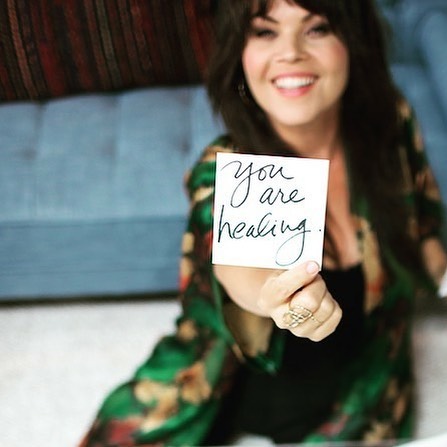
Here’s PART 2 of the two-part series: Making New Mind Grooves, A Discussion About the Neuropathways That Are Steering Your Life with Terri Cole and me.
You can read PART 1 HERE, or download the complete PDF HERE.
“Victimhood & Your Security Blanky”
D: Negative emotions have their own kind of adrenaline rush and thrill. I can see how people get hooked on them, but ultimately, that just locks you into victim mode.
T: When we get accustomed to negative feelings they become like our security blanky, our wooby. Being in love with your misery is like holding on to your wooby. But what you don’t see is that it’s not keeping you warm, there are all these holes in it, it’s filled with pieces of glass and junk, and your wooby is actually making you itch and bleed.
D: Your security blanket is toxic.
T: Yes! The truth is, you don’t need that wooby because it’s not serving you. It’s a learned helplessness that can be unlearned.
You have to ask yourself if you’re blaming others for your circumstances. Because we have no control over what other people do in our lives, even the people we love. But we have a 100% control over how we choose to respond to the way other people are in our lives and our circumstances.
We have no control over others actions, but 100% control over how we respond.
And no matter what circumstance you are in, no matter who’s doing what, even extreme circumstances of abuse, the perpetrator is 50% and the other person is 50%. Because you have choices about what to do, even though it’s scary to change.
“The Hidden Benefits of Staying in Victim Mode”
T: As much as people don’t like to think about their own victim status, it’s often there because there’s a secondary gain to it.
Secondary gain is the “benefits” to your crappy situation. It goes like this: If you’re the victim, then you get to blame other people. “If she would only change … If my boss wasn’t such an asshole, then I’d be able to shine at work …”. The secondary gain is that you don’t have to take full responsibility for your life. You don’t have to be vulnerable. You don’t have to change if you’re waiting for the other person to change first.
So let’s talk about when people stay in really terrible circumstances like an abusive relationship. This is tricky to discuss because some people reading this will be thinking, “Nobody actually wants to be in an abusive marriage!” And I agree. Consciously, nobody wants to be in that situation. But it’s a powerful example of how secondary gain works. Here, the secondary gain is very hidden. It’s about the things you get to not do as a result of enduring the situation.
For a woman or man who stays in a bad relationship, their secondary gain is that they don’t have to attempt to be in a healthy relationship and risk failing. They get to stay in a situation where they get to tell everyone how terrible the other person is. They get support and sympathy from others. They get people trying to help them. They don’t have to go out on their own, be alone in their life, and get to know themselves. They don’t have to look at why they’re staying. Again, they get to avoid being vulnerable.
Now, I’m not saying that people stay in crappy relationships for this reason alone. But as a therapist, understanding what the secondary gain is in any bad situation is very, very helpful to the client. So they can get honest about, “You know, you’re right. I’m afraid to be with someone else. I’ve never been in a healthy relationship. I don’t think I know how to do it.”
Analyze negative mind tracks. Lay down new positive ones – and make way for light.
D: So then we go back to neuropathways. Analyzing the negative tracks, and laying down new positive tracks. Full circle.
T: Full circle.
“Making Way for the Light”
D: So what do you see happen for people when they turn default thoughts into conscious, positive thoughts?
T: They’re not on auto-pilot anymore so their authentic self starts to emerge. The light in people gets turned up. I could have a client who I have seen for years — they come in feeling so beaten down, they talk about the same things. Their light has been medium to dull. When they take the bold step to stop habitual negative thought patterns, they are taking a leap into the light.
“You mean maybe I could have a good relationship? You mean that’s possible for me to have the career that I want really? Are you sure it’s not too late for me?”
Take a leap into the light.
When they stop repeating the old, negative script, new possibilities show up. When they learn that words have such power—words can keep them stuck by reinforcing negative neuropathways—they become super mindful of the way they talk to and about themselves. The expansion in their mind of their own potential has them say, “Well I used to believe this, but I don’t anymore.”
When you realize how you feel and what you think can be a choice, and you wake up enough in your life to choose thoughts and behaviors in alignment with what you want, what shifts is everything. You become more creative. You lose weight naturally. You laugh more. You get excited about your life.
D: You get excited!
T: Yep—you get really, really excited.
“Your Neuropathways on the Go”
A lifeline in an anxiety attack, or a deeper meditation for washing away fear, here’s how to point yourself toward the positive:
1. Stop the thought—abruptly if need be. A nasty thought pattern surfaces. Stop it immediately and say, “I’m not going with that thought. That causes me pain.” You can do something to change that thought. And when you change that thought, your feelings will follow.
2. Locate the thought in your body … and breathe. There’s always a constriction in your body that comes along with the limiting thought. And it’s always fear-driven—fear that you can’t control what’s happening, fear that it’s never going to change, fear that you won’t know what to do. So you name the feeling as fear and you breathe into it—breathe as slowly, as fast, as long as you need to. Visualize the fear leaving your body with every exhalation.
3. Put in some gratitude. Fill that space with gratitude. It works. If you can’t find something in your moment of fear to be grateful for, just imagine things that feel good, and pull up some pictures on your phone of people you love. As you soon as you can feel gratitude, you know you’ve moved out of the fearful thought.
4. Affirm the positive. Your affirmation can be as simple as “I’m okay.” or “I’m free.” Or as big as, “I trust in the power of the divine.” Use words to reassure yourself of the strength within you and what’s possible.

DOWNLOAD THE FULL PDF OF THIS ARTICLE HERE.
FIND TERRI
TerriCole.com
@terri_cole
Facebook














Recent Comments